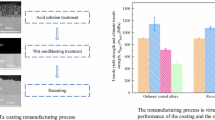Abstract
The quality of thin foil components made from NiCr-based alloys can be reduced by three-dimensional defects formed during alloy preparation and roMng cycles of foil manufacturing. In particular, the appearance of microscopic holes, i.e. defects transparent to light, air or other matter, can completely prevent special applications. Thus for the optimization of foil manufacturing procedure microanalytical investigations were needed to support the decision for either a model of solely vacancy coalescence or a combined model of vacancy coalescence in the presence of second-phase inclusions and direct interaction of inclusion and roll surface. The identification of corundum particles as a major inclusion of almost all investigated transparent defects confirms that thodefects are formed due to both different mechanical behaviour (ofα-Al2O3 inclusions and NiCr-alloy) and vacancy coalescence at the appropriate phase boundary during rolling deformation.
Similar content being viewed by others
References
A. Taylor andG. Hinton,J. Inst. Metals 81 (1952–53) 169.
H. Grover andI. Hutzenlaub,Phys. Rev. 56 (1939) 212.
C. G. Shull andE. O. Wollan,ibid. 81 (1951) 527.
C. Sykes andH. Evans,J. Inst. Metals 58 (1936) 255.
A. Taylor andR. W. Floyd,ibid. 80 (1951/52) 577.
F. Barlat, A. Barata da Rocha andJ. M. Jalinier,J. Mater. Sci. 19 (1984) 4133.
E. Houdremont “Handbuch der Sonderstahlkunde” (Springer-Verlag, Berlin, Göttingen, Heidelberg, 1956) p. 1275.
H. Schmalzried “Festkörperreaktionen” (Akademie-Verlag, Berlin, 1973) Chs. 7 and 8.
C. K. Kim andA. McLean,Met. Trans. B10B (1979) 585.
C. Greskovich andV. S. Stubican,J. Amer. Ceram. Soc. 51 (1968) 42.
E. N. Bunting Bur. Stand. J. Res. 6 (1931) 948.
J. F. Elliott, M. Gleiser andV. Ramakrishna, “Thermochemistry for Steelmaking”, Vol. 11. (Addison-Wesley, Reading, Mass., 1963).
W. G. Wilson,Werkschrift Goldschmidt 4 (1974) 26.
J. W. Colby,Adv. X-ray Anal. 11 (1968) 287.
A. Petzold andW. Hinz, “Silikatchemie” (VEB Deutscher Verlag der Grundstoffindustrie, Leipzig, 1978).
J. H. Weber andP. S. Gilman,Scripta Metall. 18 (1984) 479.
Author information
Authors and Affiliations
Rights and permissions
About this article
Cite this article
Kunze, J., Mai, H., Mucha, A. et al. Microanalytical characterization of microscopic defects in NiCr-based alloys of low impurity content. J Mater Sci 22, 325–330 (1987). https://doi.org/10.1007/BF01160588
Received:
Accepted:
Issue Date:
DOI: https://doi.org/10.1007/BF01160588




